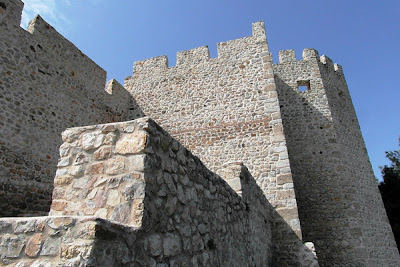 |
| Amasya Castle The principle fortification of the Roman Military Theme of Armeniac. |
Theme of Armeniac
The themes or themata were the main administrative divisions of the middle Byzantine Empire. They were established in the mid-7th century in the aftermath of the Muslim conquests of Byzantine territory and replaced the earlier provincial system established by emperors Diocletian and Constantine the Great.
In their origin, the first themes were created from the areas of encampment of the field armies of the East Roman Army, and their names corresponded to the military units they had resulted from. The theme system reached its apogee in the 9th and 10th centuries, as older themes were split up and the conquest of territory resulted in the creation of new ones. The original theme system underwent significant changes in the 11th and 12th centuries, but the term remained in use as a provincial and financial circumscription, until the very end of the Empire.
__________________________________________________
The Armeniac Theme (Greek: Άρμενιακόν [θέμα], Armeniakon [thema]), more properly the Theme of the Armeniacs (Greek: θέμα Άρμενιάκων, thema Armeniakōn) was a Byzantine theme located in northeastern Asia Minor.
First themes: 7th–8th centuries - The massive Arab invasions forced major changes in the Eastern Roman military. At some point in the mid-7th century, probably in the late 630s and 640s, the Empire's field armies were withdrawn to Anatolia, the last major contiguous territory remaining to the Empire. The armies were assigned to the districts that became known as the themes.
Territorially, each of the new themes encompassed several of the older provinces, and with a few exceptions, seems to have followed the old provincial boundaries. The first four themes were those of the Armeniacs, Anatolics and Thracesians, and the Opsician theme.
 |
| Gnaeus Pompeius Magnus Pompey the Great helped bring Amaseia into the Empire. |
The Armeniac Theme was one of the four original themes, established sometime in the mid-7th century. Although the mention of a "George, tourmarchēs of the Armeniacs" in 629, during the Persian campaigns of Emperor Heraclius (r. 610–641), may suggest the existence of the theme at such an early date, the first unambiguous reference to it in literary sources occurs during the revolt of its general, Saborios, in 667/668.
It is next mentioned on a seal of 717/718. Together with the other themes, it was created from the remnants of one of the field armies of the old East Roman army following the disastrous defeats suffered during the first wave of the Muslim conquests, a process probably complete by the late 640s.
Thus, the army of the magister militum per Armeniae (the "Armeniacs") was withdrawn and settled in the areas of Pontus, Paphlagonia and Cappadocia, giving its name to the region.
The theme's capital was at Amaseia.
Historically Amaseia was capital of the kings of Pontus until about 183 BC. Amaseia was captured by the Roman Lucullus in 70 BC from Armenia and was quickly made a free city and administrative center of his new province of Bithynia and Pontus by Pompey.
By this time Amaseia was a thriving city, the home of thinkers, writers and poets, and one of them, Strabo, left a full description of Amaseia as it was between 60 BC and 19 AD. Around 2 or 3 BC, it was incorporated into the Roman province of Galatia, in the district of Pontus Galaticus. Around the year 112, the emperor Trajan designated it a part of the province of Cappadocia.
Later in the 2nd century it gained the titles 'metropolis' and 'first city'. After the division of the Roman Empire by Emperor Diocletian the city became part of the East Roman Empire. At this time it had a predominantly Greek-speaking population.
The city's location in a steep valley makes the city a mountain stronghold, easy to defend, and thus Amasya has had a long and prominent history.
 |
| Eastern Roman Infantry Officer |
The theme was governed by a stratēgos, who ranked, together with the stratēgoi of the Anatolic and Thracesian themes, in the first tier of stratēgoi, drawing an annual salary of 40 gold pounds.
In the 9th century, it fielded some 9,000 men and encompassed 17 fortresses. Its size and strategic importance on the Byzantine Empire's north-eastern frontier with the Muslims made its governor a powerful figure, and the theme's forces participated in several revolts in the 8th century.
Consequently, in the 9th century it was broken up: the smaller provinces of Charsianon and Cappadocia were formed, first as kleisourai and later as full themes, along the border in the south and east, while in circa 819, the coastal themes of Paphlagonia and Chaldia were split off, followed later by the area of Koloneia (first under a doux, by 863 under a full strategos), leaving a rump Armeniac theme encompassing the western Pontus.
The theme remained in Byzantine hands until the late 11th century. In 1073, however, following the disastrous Battle of Manzikert, Frankish mercenaries under Roussel de Bailleul seized control and governed the region for several months, until Byzantine authority was restored by general Alexios Komnenos.
Shortly after, the region was overrun by the Seljuk Turks, with only a few coastal forts holding out. In 1075 following 700 years of Byzantine rule Amasya was conquered by the Turkmen Danishmend emirs. It became their capital until it was annexed by the Seljuk ruler Kiliç Arslan II.
The Komnenian emperors managed to recover the coastal regions for the Empire, but the Armeniac theme was not restored.
Amasya - View from the Castle
 |
| Armeniac Theme Theme of the Eastern Roman Empire 640s/660s – ca. 1073 Capital Amaseia Fell in 1073 to Frankish mercenaries and then Seljuks |
 |
| Modern Amaseia. The city served as capital of the Roman theme of Armeniac. |
(Byzantine Themes) (Armeniac Theme) (fazturkey.com) (About Amasya)








No comments:
Post a Comment